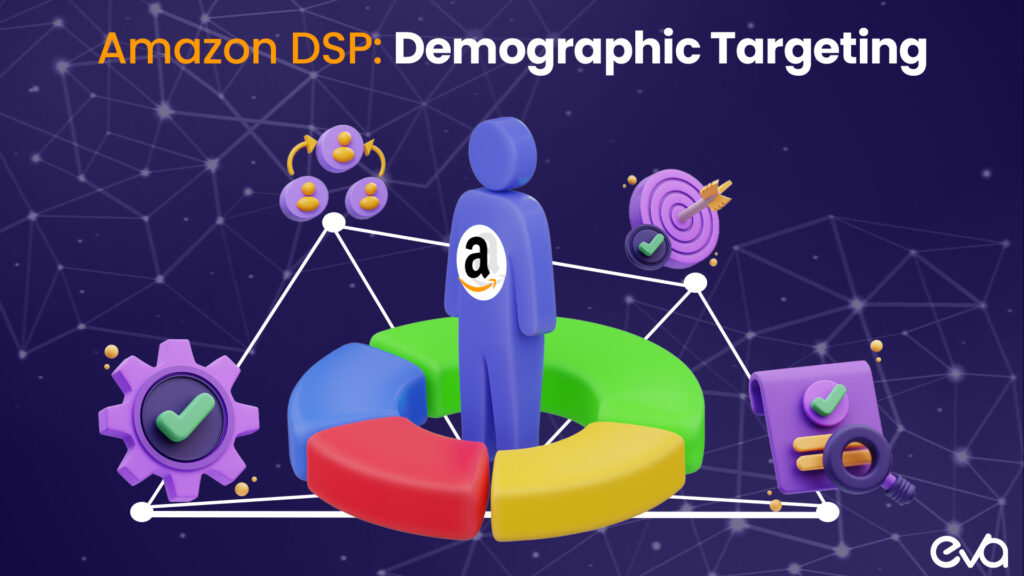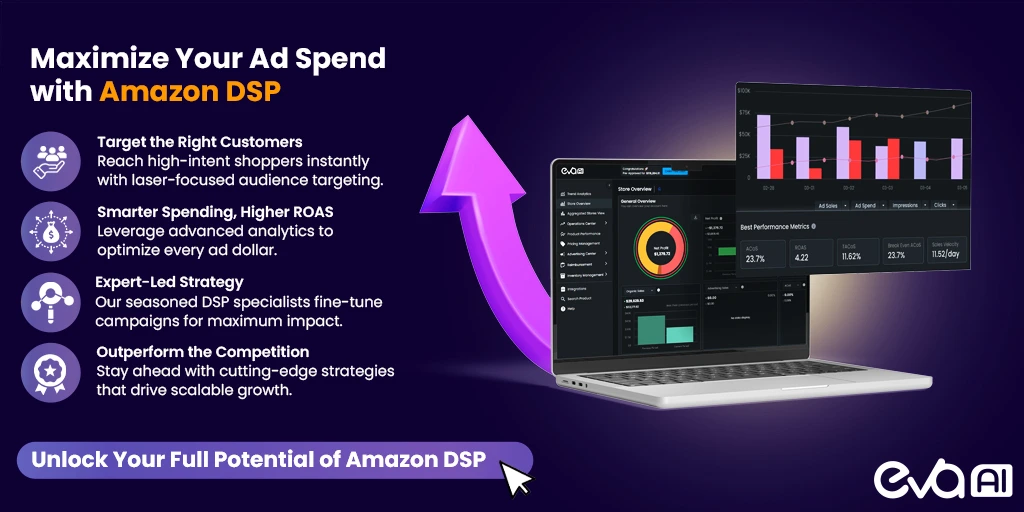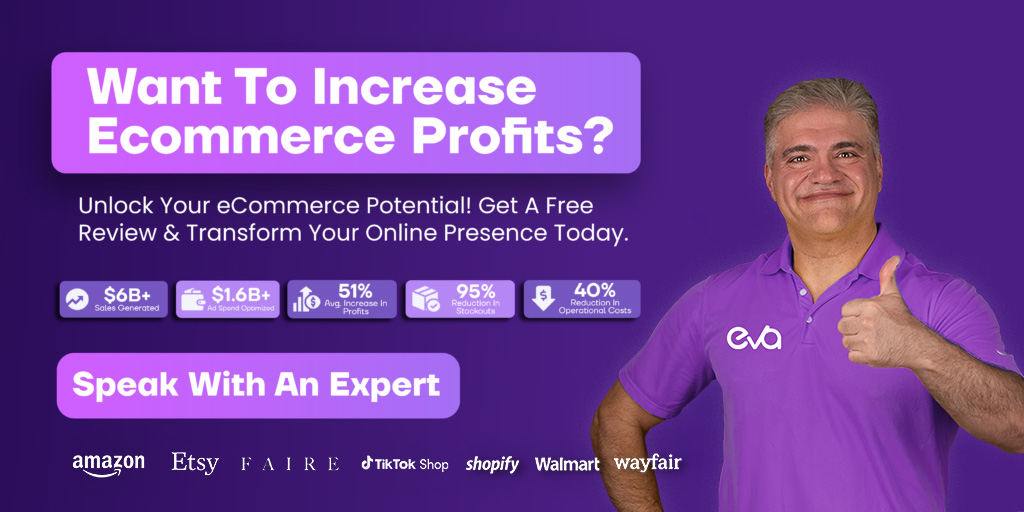Table of Contents
Introduction
Digital advertising thrives on precision, and Amazon DSP (Demand-Side Platform) is a powerful tool that allows advertisers to buy display, video, and audio ads programmatically.
By using Amazon’s extensive ecosystem, businesses can target their audience with incredible accuracy.
This article explores the crucial role demographic targeting plays within Amazon DSP and how it can improve your advertising campaigns.
What is Demographic Targeting?
Demographic targeting is a strategy used in digital marketing to segment an audience based on characteristics like age, gender, income, location, and education level.
This approach allows marketers to craft messages that resonate with specific groups who are most likely to be interested in their products or services.
In Amazon DSP, demographic targeting enables advertisers to pinpoint audience segments based on detailed demographic data, ensuring ads reach the most relevant audience.
This increases engagement and conversion rates.
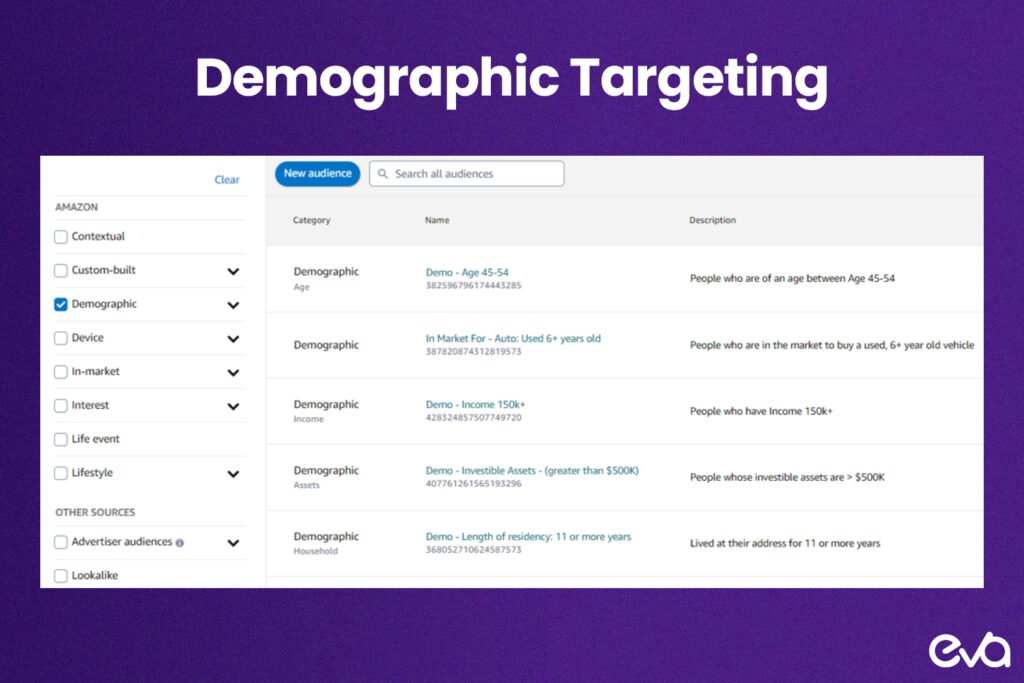
How Demographic Targeting Works in Amazon DSP
Amazon DSP provides strong demographic targeting capabilities, including:
- Audience Segmentation: Choose from pre-defined audience segments based on age, gender, income, and interests. These segments align with your campaign goals and target specific groups.
- Custom Audiences: Create custom audiences using first-party data, such as customer demographics, purchase history, and browsing behavior, for even more tailored targeting.
- Lookalike Audiences: Amazon DSP can generate lookalike audiences based on your existing customer base, helping you reach new users who share similar characteristics with your current customers.
For example, when promoting a luxury product, you might target an audience segment with higher income brackets, ensuring your ads are seen by individuals more likely to purchase.
Similarly, if you’re launching a new line of children’s toys, you could target parents with young children, increasing the relevance of your ads.
Examples of Demographic Data
Demographic data used in targeting can include:
- Age: Tailoring messages to resonate with the specific needs and preferences of each age group.
- Gender: Crafting personalized and effective ad campaigns by understanding gender-based consumer behavior.
- Income: Targeting ads based on the purchasing power of your audience.
- Location: Ensuring your ads are relevant to the audience’s geographic location, particularly useful for local businesses or region-specific campaigns.
- Education Level: Reaching audiences based on their education level, crucial for products or services that cater to specific knowledge or expertise levels.
- Family Status: Personalizing messages based on family size or status.
- Cultural and Ethnic Background: Creating campaigns that resonate with different cultural groups.
Combining these demographic factors within Amazon DSP allows for highly specific audience segments that align with your campaign objectives.
Why Demographic Targeting Matters?
Demographic targeting is vital in any marketing strategy. It allows for:
- Increased Relevance: Ads that speak directly to a person’s demographic characteristics are more likely to capture attention and resonate with their needs or desires.
- Improved Conversion Rates: Relevant ads lead to higher conversion rates, as demographic targeting helps ensure the right people see the right message at the right time.
- Optimized Ad Spend: By narrowing your target audience, you reduce wasted ad spend on individuals unlikely to convert, maximizing your advertising investment.
The Impact of Precise Targeting on Campaign Success
Precise demographic targeting can have a significant impact. According to a study by Nielsen, campaigns using precise demographic targeting achieve up to a 30% increase in ad recall and a 20% increase in brand lift compared to non-targeted campaigns.
How These Concepts Overlap and Differ in Application
The overlap between target market and demographic targeting lies in their shared goal of reaching the right audience. However, they differ in application:
- Target Market: Identifies the overall audience you want to reach, which may include multiple demographic segments.
- Demographic Targeting: Refines your message to resonate with specific demographic groups within that broader market.
For instance, a company selling sports apparel might identify its target market as “active individuals aged 18-45.” Within this market, they could use demographic targeting to create tailored campaigns for different age groups, such as “18-24-year-old college students” or “35-45-year-old working professionals,” each with unique messaging and product offerings.
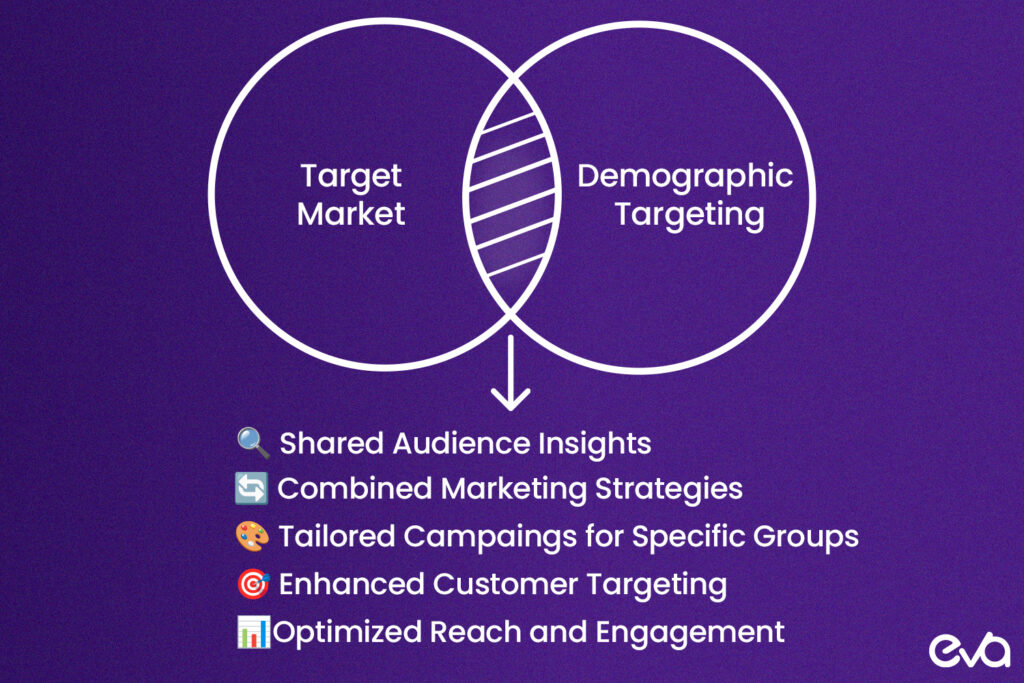
Examples to Illustrate the Distinction
Consider a fitness brand marketing both to young adults and older adults. While the overall target market might include both age groups, demographic targeting allows the brand to create separate campaigns:
- Young Adults (18-24): Emphasize trendy, affordable workout gear with messaging that resonates with college students and young professionals.
- Older Adults (35-45): Focus on the durability and quality of the gear, positioning it as a long-term investment for health and wellness.
By distinguishing between the target market and demographic targeting, marketers can deliver more effective campaigns that speak directly to the needs and preferences of each demographic segment.
Key Demographic to Consider
Implementing demographic targeting within Amazon DSP requires a solid understanding of the key demographic factors that can influence your campaign’s success. Let’s explore these factors:
- Age
Is one of the most fundamental demographic factors. Different age groups have distinct preferences, behaviors, and purchasing power, which can significantly impact how they respond to advertising.
- Generation Z (18-24 years): Digitally native, values social media engagement, and is often influenced by online trends and peer recommendations. Campaigns targeting Gen Z should use platforms like Instagram, TikTok, and YouTube, focusing on visually appealing and trendy products.
- Millennials (25-39 years): Known for brand loyalty and value-consciousness, Millennials often seek products that offer both quality and affordability. They respond well to content that highlights brand values, sustainability, and social responsibility.
- Generation X (40-54 years): Values practicality and tends to be more brand loyal. Campaigns targeting Gen X should focus on products that offer convenience, quality, and reliability.
- Baby Boomers (55-75 years): With significant purchasing power, Baby Boomers respond well to straightforward, informative content. They appreciate campaigns that emphasize product benefits and customer service.
- Gender
Plays a critical role in shaping consumer behavior. Understanding these differences can lead to more effective targeting.
- Female Consumers: Often influenced by emotional appeals and tend to prioritize value and quality. They engage more with brands that emphasize community and social responsibility.
- Male Consumers: Typically respond to ads that focus on product features, performance, and efficiency. They are often attracted to straightforward, factual messaging and are more likely to make impulse purchases.
When targeting based on gender, consider the product type and how it relates to the interests and needs of different genders.
For example, a skincare brand might create separate campaigns for men and women, highlighting different product benefits and usage scenarios.
- Income
Is a significant factor in determining a consumer’s purchasing power and the type of products or services they are likely to buy.
- High-Income Consumers: Often willing to pay a premium for luxury products, exclusivity, and high-end features. Campaigns targeting high-income consumers should focus on quality, exclusivity, and prestige.
- Middle-Income Consumers: Value-conscious and look for a balance between quality and affordability. They respond well to campaigns that highlight deals, discounts, and the overall value proposition.
- Low-Income Consumers: Price sensitivity is crucial for this group. Campaigns should emphasize affordability, practicality, and essential product benefits.
Table: Income-Based Targeting Strategies
| Income Bracket | Campaign Focus | Key Messaging |
| High-Income | Luxury, exclusivity, premium quality | “Experience the ultimate in luxury” |
| Middle-Income | Value, affordability, quality | “Best value for your money” |
| Low-Income | Affordability, practicality | “Affordable solutions for everyday needs” |
- Location
Geographic location is another vital demographic factor, especially for businesses with region-specific products or services.
- Urban Areas: Consumers in urban areas often have access to a wide range of products and services. They tend to value convenience, speed, and innovation. Campaigns targeting urban consumers should focus on fast delivery, latest trends, and exclusive urban offerings.
- Rural Areas: Consumers in rural areas may prioritize practicality, durability, and cost-effectiveness. Campaigns should highlight the product’s reliability, long-term value, and adaptability to rural lifestyles.
Geographic targeting within Amazon DSP allows you to deliver ads tailored to the specific needs and preferences of consumers in different locations, ensuring maximum relevance and impact.
- Education Level
Can influence a consumer’s purchasing behavior, interests, and responsiveness to different types of messaging.
- Higher Education: Consumers with higher education levels often value in-depth information, innovation, and expert endorsements. Campaigns targeting this group should provide detailed product information, case studies, and testimonials from experts.
- Lower Education: This group might prefer straightforward, easy-to-understand messaging that clearly outlines the product’s benefits and value.
- Family Status
Can significantly affect purchasing decisions, particularly for products related to home, family, and lifestyle.
- Single Consumers: Often more focused on self-care, lifestyle products, and experiences. Campaigns might highlight convenience, personal benefits, and lifestyle enhancement.
- Married Couples: Likely to prioritize family-oriented products, such as home goods, children’s products, and financial planning services. Campaigns should focus on family benefits, safety, and long-term value.
- Parents with Young Children: This group values safety, practicality, and educational benefits. Campaigns should emphasize child safety, developmental benefits, and ease of use.
What Are the Demographic Targeting Options?
Overview of Amazon DSP’s Demographic Targeting Capabilities
Amazon DSP offers a variety of demographic targeting options that enable advertisers to reach their desired audience with precision. These capabilities include:
- Pre-Defined Audience Segments: Amazon DSP provides several pre-defined demographic segments based on factors like age, gender, income, and interests. These segments are derived from Amazon’s first-party data, ensuring accuracy and relevance.
- Custom Audience Creation: Advertisers can create custom audiences using first-party data, such as customer demographics, purchase history, and browsing behavior. This allows for highly tailored campaigns that align with specific marketing objectives.
- Lookalike Audiences: Amazon DSP’s lookalike audience feature allows advertisers to reach new users who share similar characteristics with their existing customers. This expands the reach of campaigns while maintaining relevance.
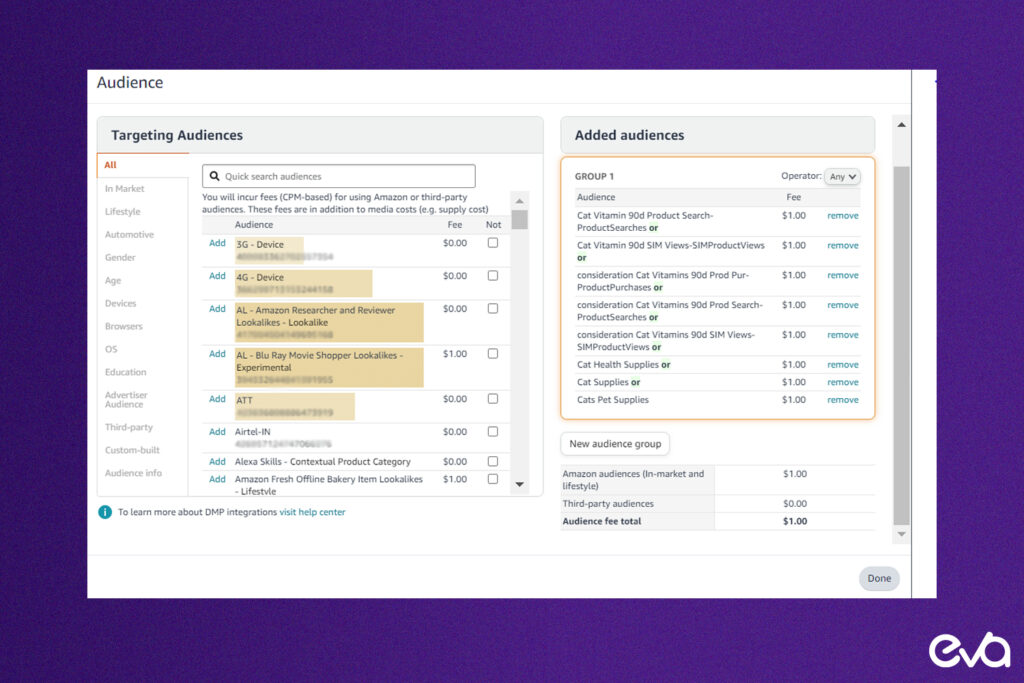
How to Select the Right Demographic Options for Your Campaign
Choosing the right demographic options within Amazon DSP involves several key considerations:
- Campaign Objectives: Define the goals of your campaign. Are you aiming for brand awareness, lead generation, or sales conversion? Your objectives will guide your choice of demographic segments.
- Audience Insights: Leverage data from previous campaigns, market research, and customer analytics to identify the most relevant demographic segments.
- Budget Allocation: Consider your budget when selecting demographic options. Targeting highly specific segments might require more budget allocation, but can also lead to higher ROI.
- Testing and Optimization: Start with broader demographic segments and gradually refine your targeting based on campaign performance. Use A/B testing to determine which demographic segments yield the best results.
How to Use Demographic Targeting
Implementing demographic targeting within Amazon DSP requires a methodical approach to ensure your campaigns effectively reach the right audience.
Here’s how you can set up demographic targeting, follow best practices, and avoid common mistakes:
Step-by-Step Guide to Setting Up Demographic Targeting in Amazon DSP
- Define Your Campaign Goals: Clearly outline what you want to achieve with your campaign, whether it’s increasing brand awareness, driving conversions, or generating leads. Your goals will influence your targeting strategy.
- Access the Amazon DSP Console: Log into your Amazon DSP account and navigate to the campaign creation dashboard.
- Choose Your Audience Segment: Select from pre-defined demographic segments or create custom audiences based on your data. For example, you might choose segments like “High-Income Families” or “Millennial Shoppers.”
- Set Up Demographic Filters: Apply demographic filters to narrow down your audience. You can target specific age groups, genders, income levels, locations, and more.
- Incorporate Behavioral Data: Combine demographic targeting with behavioral insights. For instance, target users who have recently searched for luxury products or have made multiple purchases in a specific category.
- Select Ad Placements: Choose where your ads will appear. Amazon DSP allows you to select placements across Amazon-owned sites and apps, as well as third-party websites.
- Set Your Budget and Bidding Strategy: Determine your campaign budget and set your bidding strategy. Amazon DSP offers various bidding options, such as cost-per-mille (CPM) and cost-per-click (CPC), allowing you to optimize your spending based on your campaign goals.
Tools and Features Within Amazon DSP that Support Demographic Targeting
Amazon DSP offers several tools and features that enhance demographic targeting:
- Audience Builder: Create custom audience segments based on a combination of demographic, behavioral, and geographic data. You can save these segments for future campaigns, ensuring consistency in your targeting strategy.
- Reporting Dashboard: Amazon DSP’s reporting tools provide detailed insights into campaign performance, including metrics such as impressions, clicks, conversions, and demographic breakdowns. This data is crucial for optimizing your targeting strategy.
- Creative Optimization: Amazon DSP’s creative optimization tools help you tailor ad creatives to different demographic segments. You can create multiple ad variations and let the platform automatically optimize for the best-performing creative.
- Integration with Amazon Marketing Cloud: For more advanced targeting and measurement, Amazon DSP integrates with Amazon Marketing Cloud, providing deeper insights into customer journeys and allowing for more precise audience segmentation.
Comparison with Other Solutions in the Market
Compared to other solutions in the market, our demographic targeting platform offers flexibility, precision, and support.
While many platforms offer basic demographic targeting, we go beyond the basics with advanced segmentation, custom audience creation, and real-time optimization.
This ensures that your campaigns are always reaching the right audience at the right time.
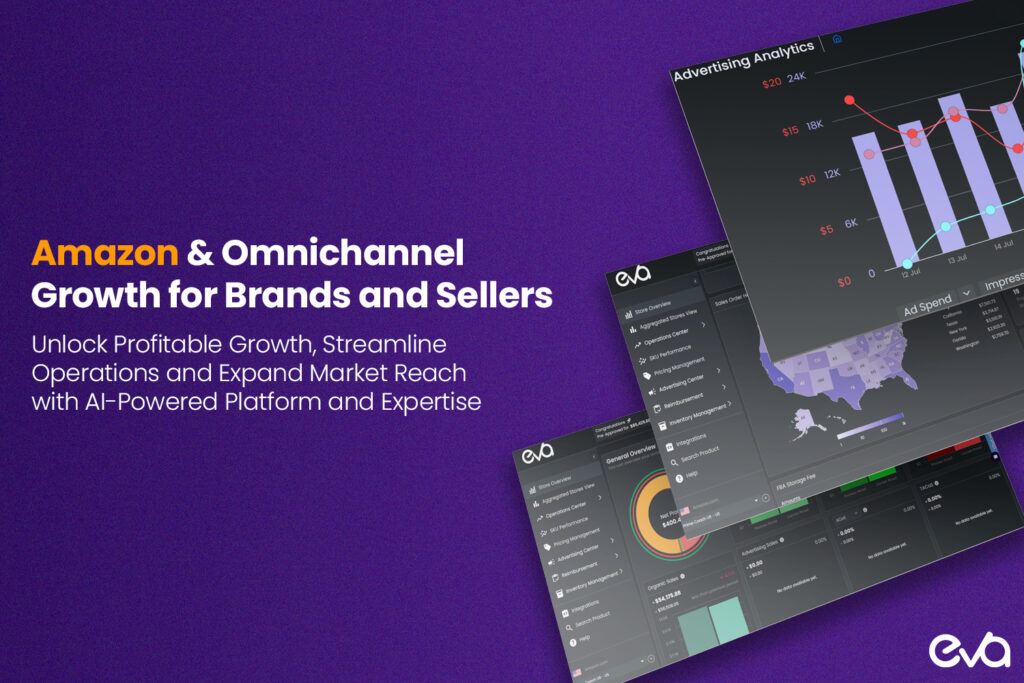
How Eva Can Help with Amazon DSP Demographic Targeting
Eva is designed to improve your Amazon DSP campaigns by offering advanced demographic targeting capabilities. Here’s how Eva can make a difference:
- AI-Driven Insights: Eva uses AI algorithms to analyze vast amounts of data and identify the most effective demographic segments for your campaigns.
- Custom Strategy Development: Eva’s team works with you to develop strategies tailored to your business goals and target audience.
- Seamless Integration: Eva integrates with Amazon DSP, allowing you to use its full suite of targeting options without technical hurdles.
- Dedicated Support: Eva provides ongoing support and optimization to ensure your campaigns consistently perform well.
Benefits
Partnering with Eva offers several benefits for your Amazon DSP demographic targeting efforts:
- Increased Efficiency: Eva’s AI-driven insights help you identify the most valuable demographic segments, reducing waste and increasing ad efficiency.
- Improved Performance: By targeting the right audience with precision, Eva ensures that your campaigns achieve higher engagement rates and better conversion outcomes.
- Cost Savings: Eva’s optimization tools help you allocate your budget more effectively, ensuring you get the best possible return on investment (ROI).
- Expert Guidance: With Eva’s dedicated support, you’ll have access to expert guidance on demographic targeting best practices, helping you stay ahead of the competition.
Eva leverages AI-driven insights and custom strategies to optimize your demographic targeting on Amazon DSP.
Our solutions ensure you reach the right audience segments, boosting engagement and maximizing ROI. With Eva’s expertise, your campaigns will see enhanced performance and greater cost-efficiency.
Ready to take your Amazon DSP campaigns to the next level?
Explore how Eva can help you achieve success with advanced demographic targeting. Click here to learn more and start optimizing your campaigns today!
Conclusion
Demographic targeting within Amazon DSP is not just a powerful tool—it’s a game-changer for any digital advertising strategy.
By honing in on specific audience characteristics such as age, gender, income, and location, you can create highly personalized campaigns that speak directly to your target audience’s needs and desires.
This precision leads to higher engagement, improved conversion rates, and a more efficient use of your advertising budget.
Partnering with Eva allows you to unlock the full potential of Amazon DSP’s demographic targeting capabilities, driving meaningful results and maximizing your return on investment.
With Eva’s AI-driven insights and expert support, your campaigns won’t just reach the right people—they’ll resonate with them.
Ready to take your Amazon DSP campaigns to the next level? Book a meeting now!
FAQs
Demographic targeting focuses specifically on audience characteristics like age, gender, income, and location. Other types of targeting, such as behavioral targeting, focus on user actions and behaviors, like recent searches or purchase history.
Yes, Amazon DSP allows you to target multiple demographic factors simultaneously. For example, you can target “Women aged 25-34 with an income of $50,000+ living in urban areas.”
For e-commerce businesses, the most effective demographic factors often include age, income, and location. These factors influence purchasing behavior and can be used to tailor product recommendations and promotional offers to specific audience segments.
Success can be measured using various metrics, including click-through rates (CTR), conversion rates, and return on ad spend (ROAS). Amazon DSP’s reporting tools provide detailed insights into how each demographic segment is performing, allowing you to make data-driven adjustments to your campaigns.
Demographic targeting is an overpowered tool in digital advertising, as it helps you reach the audience segments that matter most. By using Amazon DSP’s targeting capabilities, you can improve the effectiveness of your campaigns, boost conversion rates, and get a better return on your investment.

